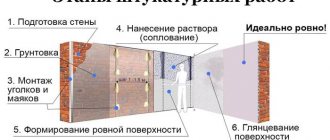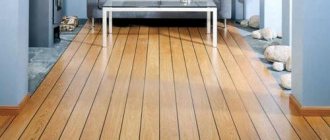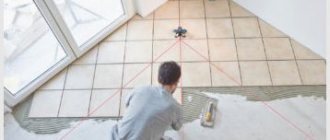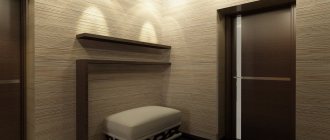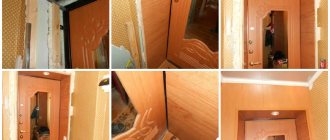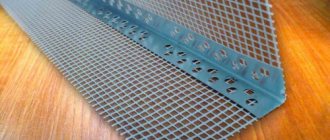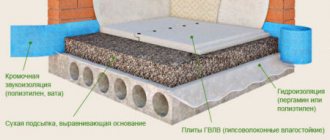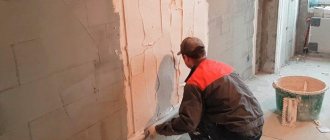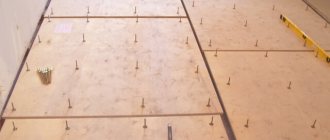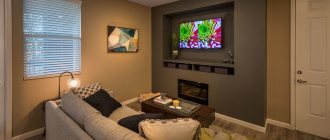Using vinyl laminate
Vinyl or flexible laminate is a new type of flooring. Unlike its older brothers, chipboard or fibreboard can be placed on a not entirely level base.
This type of laminate is made from two layers:
- polyurethane and aluminum oxide;
- vinyl.
Along the perimeter of the plank there is a vinyl edge protruding a couple of centimeters. An adhesive base (smart tape) is applied to it. Using this technology, laminate planks are glued to each other and form a “floating” surface.
Such a connection will not break on an uneven floor due to its elasticity and can withstand differences of up to 5 mm. This laminate is much stronger and has a strength class of 42 - 43.
Hide behind cork sheets
This method is suitable for highlighting an accent wall in a room: cork has an interesting texture, is environmentally friendly and budget-friendly. Perfectly diversifies the interior in Scandinavian or eco-style. It does not require special preparation of the walls, and installation is not difficult - you only need a primer and special glue. Cork panels look great in a nursery or home office.
Wooden panels will not only hide unevenness on the walls, but will also give the room a luxurious effect. Since wood is a rather expensive material, panels decorated to look like wood would be a cheaper option. Visually, they are practically no different from natural material.
Paste wallpaper
Probably the simplest and most common way to hide unevenness on the wall is to hang wallpaper. However, there are some nuances here. So, plain thin wallpaper is not suitable for this purpose. The best solution would be non-woven or vinyl wallpaper. Their main qualities are multi-layering, density and multi-layer embossing. As for drawing, it is better to give preference to ornament, geometric shapes, and abstraction. Such wallpaper will easily hide small defects on the walls.
Use wood panels
Wooden panels will not only hide unevenness on the walls, but will also give the room a luxurious effect.
Since wood is a rather expensive material, panels decorated to look like wood would be a cheaper option. Visually, they are practically no different from natural material. It is worth considering that wooden panels are not suitable for finishing a small room. The fact is that they visually reduce the space.
Upholster with clapboard
Lining is a thin cladding board, which is the result of wood processing.
This material is practical, has a relatively low price, long service life and sound insulation. Another advantage of the lining is the ability to paint it in any color. Wall upholstery with clapboard will fit perfectly into the Scandinavian style, Provence or eco-style.
Hide defects behind drywall
Another relatively cheap and easy-to-install way to hide defects is to decorate the walls with plasterboard. This material is resistant to mechanical stress, fireproof, moisture resistant, and even insulates walls. If desired, drywall can be covered with wallpaper, painted or covered with tiles.
Make a “green” corner
This option will be an excellent solution to the problem if only one wall in the room is uneven. In this case, it can be turned into a phytowall. The scope of imagination is not limited: you can place shelves on the wall in a chaotic manner and display flowers on them, or distribute branches of weaving vines along the wall.
Such a living corner will add extravagance to the room. In addition, fresh flowers perfectly purify the air and have a calming effect.
Decorate a wall with a curtain
An interesting solution for those who like to experiment is to “hide” an uneven wall behind a curtain. This kind of deception will not go unnoticed and will give the room a special chic. As for the curtain itself, the material should be dense and have a complex texture. At the same time, it is advisable to choose textiles that will not easily get dirty and fade in the sun. The color of the curtain should be in the same range as the color of the wall.
Choose unusual material
One such option is cork panels. Finishing a wall with cork has a number of advantages:
- does not require special preparation of walls;
- ease of installation;
- hides flaws well;
- fits original into the interior.
In addition, cork panels can be chosen in any texture and color, which will allow them to easily blend into any stylistic direction.
Decide to experiment
Those who don't shy away from bold decisions will love the decision to paint uneven walls dark blue, gray or black. To prevent such an interior from causing depression, you should adhere to the following design techniques: Step 1. Place bright accents. So, a bedspread, pillows, a chair or a carpet must be in light shades. In addition, you can hang a bright picture on one of the walls, and place a fresh flower in the corner of the room.
Step 2. Lamps. The more powerful the lighting in the room, the better. At the same time, the light should not come to the walls, but from them. Therefore, it is better to place lamps or sconces in niches or under drywall.
Divert attention
To avoid focusing on uneven walls, it should be focused on the original decorative elements. For example, defects can be hidden behind a large painting or poster. At the head of the bed or on the wall along the sofa, you can place an unusual panel or install a shelf with original figurines.
Enhance the unevenness effect
If you can’t get rid of the unevenness of the walls, then why not use them to your advantage? So, you can emphasize the relief of the walls with the help of lighting: wall lighting from below, ceiling chandeliers, as well as spotlights. As a result, the room will be transformed in an original way, and irregularities will become part of the interior.
To remove wallpaper you will need:
Cork
It does not lose popularity in the wake of eco-trends and the universal love for natural, quickly renewable materials.
Cork wall decoration does not require careful surface preparation and hides unevenness well. It is usually used to highlight one accent wall in a room. Convenient for children's and home office.
How to paint the walls: 5 hits from
Once upon a time, painted walls were associated with the faceless corridors of government agencies; they were looked at as a specific overseas trend and an unconventional alternative to wallpaper.
Today, paint in Russian interiors is actively gaining popularity. Simple ways to hide unevenness without leveling will help to visually straighten “littered” walls, but you need to keep in mind that most of the tips work provided there are small differences in the surface.
#Wallpaper #Wood #Decor #Textiles
Frameless method
This method is suitable for leveling walls only when the surface has minor differences and unevenness. It involves gluing sheets directly to the wall using special glue. Depending on the degree of unevenness, several methods are used:
- For differences and unevenness of up to 4 mm, plasterboard sheets are glued to the walls using gypsum putty, applying it in longitudinal rows along the entire sheet.
- For unevenness up to 2 cm, use drywall adhesive. Apply glue in piles, maintaining a distance of 30–35 cm.
- Surface differences of up to 4 cm require more complex work. Strips of drywall are attached to the wall using glue, and sheets are glued onto them.
USEFUL INFORMATION: Is it necessary to prime the walls after puttying before wallpapering?
When using the frameless method, dirt, dust and greasy stains are removed from the surface. If there are damp areas, additional drying is carried out.
Important! Large projections on the walls must be knocked down. This will greatly facilitate the leveling process and reduce material consumption.
If the surface absorbs moisture well, then it is coated with a primer. The primer also increases the adhesion of concrete walls. [smartcontrol_youtube_shortcode key=”gluing plasterboard” cnt=”4" col=”2" shls=”true”] Leveling walls with plasterboard using the frameless method is carried out in the following order:
- Detection of differences and irregularities using a building level or plumb line.
- Choosing a method for gluing drywall sheets.
- Marking the leveled surface.
- Trying and cutting drywall with parallel cutting of holes for communications.
Glue or putty is applied to the back of the sheet using a spatula. Glue the sheets, leaving a gap from the ceiling and from the floor of at least 10 mm.
Repair of uneven walls
If serious surface defects are detected (when the wall is clearly crooked in plumb line, or significant defects are visible on its surface), no correct paint will help us. We'll have to start repairing the wall. What do we need for this?
- Plasterboard sheets are a very quick and effective solution for leveling a wall. Simply attach the drywall to the wall and paint it the color of your choice. Thanks to this, we will get a smooth, even and aesthetic surface;
- Repair compound for walls is a special product that should be applied directly to the wall. This mass fills almost any type of unevenness. To make painting easier, we can apply a smooth coating to the mass;
- Smooth plaster - This should be a product specifically designed to remove uneven surfaces.
